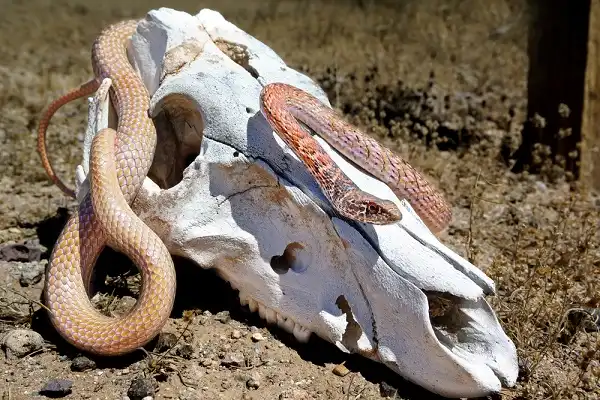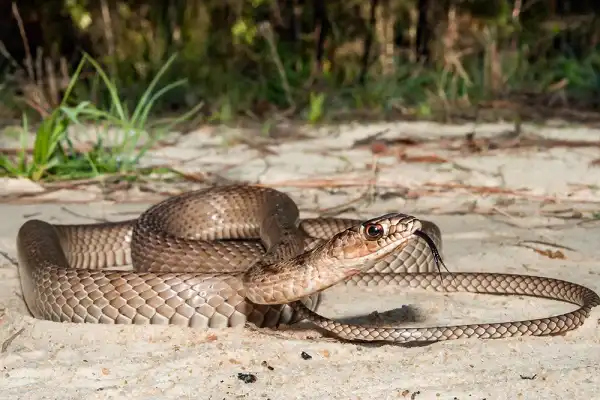If you’re looking for a new and interesting pet, you might want to consider a coachwhip snake. These snakes are not only unique, but they’re also relatively easy to care for. In this blog post, we’ll give you an overview of everything you need to know about coachwhip snakes.

Coachwhip Snake Description
Coachwhip snakes are slender, medium-sized snakes that are found primarily in the southeastern United States. Their coloring can range from light browns or grays to bright reds or yellows. The most distinctive feature of coachwhip snakes is their long, whip-like tail which can be used for several purposes including defense, movement, and balance. Overall, coachwhip snakes make interesting and unique pets that require fairly minimal care compared to other reptiles such as turtles or iguanas. With proper housing and food sources available, these snakes can live anywhere from five to fifteen years depending on species and environment.
Coachwhip Snake Habitat
Coachwhip snakes are found primarily in the southeastern United States, ranging from Texas and Louisiana to Georgia, Florida, and as far north as Virginia. They tend to inhabit dry habitats such as open woodlands, grasslands, scrubland, and deserts with plentiful vegetation for hiding. Coachwhip snakes also favor areas where there is plenty of food available — small rodents and other prey. In the wild, coachwhip snakes live in burrows or under rocks or debris. When threatened, they will coil into a defensive posture and raise their head off the ground or flatten against it so that they can strike rapidly if necessary. Coachwhips prefer temperatures between 75-85°F (24-29°C), although they can survive cooler temperatures for short periods of time without any harm. They will also bask in the sun on warm days but move to a cool spot during hot weather. As semi-arboreal creatures, coachwhips may climb trees or shrubs in search of prey or to escape danger. The humidity level within the enclosure should remain at 40%-50% relative humidity at all times – any higher levels will make your pet uncomfortable which can lead to stress or health problems over time. To maintain this level of humidity you may need to mist twice daily or use an automatic device like an ultrasonic fogger that releases mist intermittently throughout the day.
Coachwhip Snake Diet
Coachwhip snakes primarily feed on small rodents, birds, and lizards in the wild. In captivity, they can be fed pre-killed prey such as mice or rats to ensure their safety. It is important to feed your coachwhip snake appropriately sized meals — it should take them no longer than a few minutes to finish a meal. Feeding larger prey can result in regurgitation or difficulty digesting the food. Additionally, juveniles should be fed every 5-7 days while adults should only be fed once a week. It is best to provide your pet with a variety of meals as this will give them a balanced diet and reduce the risk of nutritional deficiencies. Offer different sizes of mice or rats that are appropriate for the size of your snake, as well as crickets, waxworms, and other invertebrates. If available, you may also feed your coachwhip snake small amounts of fish such as trout or salmon which contain essential vitamins and minerals.

Coachwhip Snake Size
Coachwhip snakes can vary in size depending on the species and their geographic location. Generally, they can range from 30 cm (12 in) to over 2 m (6 ft) long. Eastern Coachwhips (Masticophis flagellum flagellum) typically measure between 54-90 cm (21-36 in), while Western Coachwhips (Masticophis flagellum testaceus) are often around 90-183 cm (36-72 in). The larger subspecies, such as the Texas coachwhip (Masticophis flagellum lineaticauda) or the Red Racer (Coluber constrictor flaviventris), may reach up to 2 m (6 ft). In addition to geographic differences, size may also depend on age, with young coachwhips being much shorter than adults. As hatchlings, these snakes typically measure about 20 cm (8 in) but can grow up to 56 cm (22 in) within a year.
Coachwhip Snake Lifespan
The lifespan of coachwhip snakes can vary depending on the species, as well as their environment. Generally, these reptiles live between 8 to 10 years in captivity, while they can live up to 15 years with proper care and nutrition. In the wild, they tend to have a shorter lifespan due to predation and other environmental factors. The eastern coachwhip (Masticophis flagellum flagellum) is found throughout the southeastern United States and can reach an average age of 11 years. These snakes are most commonly found in sandy soils along the coastlines and in areas with open woodlands. The western coachwhip (Masticophis flagellum testaceus) inhabits much of the arid regions in the southwestern United States and has been reported to live for up to 12 or 13 years. The Texas coachwhip (Masticophis flagellum lineaticauda) is typically found in Texas but can also be found throughout parts of Oklahoma and Louisiana. This species has been known to reach ages 14-15 years when given proper care and nutrition. It is also important to note that males tend to have longer lifespans than females, likely due to their larger size which gives them an advantage when it comes to competing for resources or avoiding predators.
Coachwhip Snake Behavior
Coachwhip snakes are active diurnal creatures and, depending on the season and their geographic location will choose to spend most of their days on the move or in search of prey. They tend to bask during the cooler hours of the day and hunt as temperatures rise. These reptiles are also incredibly fast when it comes to locomotion, which helps them evade predators as well as capture prey with great agility. These reptiles also exhibit a unique form of communication known as ‘tail rattling’. This involves rapidly shaking their tail back and forth while facing another individual or potential threat – which is believed to be an attempt to scare off danger or ward off competition for resources. Coachwhips will also hiss and open their mouths widely when they feel threatened in order to appear larger than they actually are. In terms of social behavior, coachwhips are solitary creatures who prefer to keep to themselves except during mating season or when fighting over food sources. Mating usually occurs between March and October with females laying anywhere from 3-15 eggs at a time depending on their size and health status. The eggs will hatch within 2 months after which the young snakes are left on their own without parental care or protection.

Coachwhip Snake Speed
Coachwhip snakes are known for their incredible speed which can be attributed to their slim, elongated bodies and powerful muscles. They can reach speeds of up to 15 miles per hour (24 km/h) making them one of the fastest land-dwelling snakes in the world. Furthermore, they have impressive acceleration capabilities allowing them to quickly change direction or dive into burrows when necessary. The coachwhip’s top speed is mainly used for escaping predators or chasing down prey but can also be used for other activities such as exploring its environment or even mating with other members of its species. In addition to its impressive speed, it is also able to make tight turns and navigate complicated terrains with ease due to its flexible body and a long tail which helps balance and stabilize it while moving at high speeds. Given the facts mentioned above it is easy to see why coachwhip snakes are considered among the fastest land-dwelling reptiles in the world today! They can reach remarkable speeds when given the opportunity thanks to their slim body shape and powerful muscles as well as an energy-rich diet that keeps them powered for long periods of time. Furthermore, their great agility allows them not only to flee from danger but also to explore new territories with great ease – making them an impressive and awe-inspiring species!
Coachwhip Snake Hunting
Coachwhip snakes are highly skilled hunters that employ a number of tactics in order to catch their prey. They have a keen sense of smell and excellent eyesight which allows them to easily spot potential targets from afar. When they spot their target, they will usually sneak up on it before striking with lightning speed – using their long bodies to coil up around the animal or wrap themselves around trees to ambush unsuspecting victims. In addition to the aforementioned techniques, coachwhips have been known to use a ‘death roll’ method when hunting larger prey such as rodents and rabbits. This involves grasping onto the animal with their powerful jaws and then rapidly rolling over and over while tightening their grip until the prey is killed. After that, they will swallow their meal whole – head first – in order for it to fit inside their narrow throat. Furthermore, coachwhips can also hunt at night thanks to thermoreceptors located on their heads which enable them to detect warm-blooded prey from up to several yards away even in complete darkness. They also possess heat-sensing pits between their eyes and nostrils which allow them to locate small animals such as frogs or lizards by detecting faint infrared signals given off by these animals when they move about in search of food or mates.

Conclusion
The coachwhip snake is a remarkable species that has adapted to its environment in order to survive and thrive. Its speed, agility, keen senses, and powerful jaws all contribute to making it one of the most efficient predators in the world today. Furthermore, their impressive physical capabilities also give them an edge when exploring new areas or fleeing potential danger – allowing them to remain as successful as ever in their natural habitats! All things considered, it is clear why coachwhips are so highly regarded among reptile enthusiasts and conservationists alike – for their unique abilities provide us with insight into how nature works in order to ensure the survival of the fittest.
Frequently Asked Question

